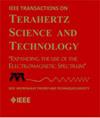A 200–280 GHz InP HBT Power Amplifier Using Double-Stacked Common-Base Core With Design Analysis and Modulation Measurements
IF 3.9
2区 工程技术
Q2 ENGINEERING, ELECTRICAL & ELECTRONIC
IEEE Transactions on Terahertz Science and Technology
Pub Date : 2025-03-09
DOI:10.1109/TTHZ.2025.3568610
引用次数: 0
Abstract
We present a WR-3.4 power amplifier (PA) using a 250-nm InP heterojunction bipolar transistor process, which exhibits a broad 3-dB bandwidth of output power. A capacitive base degeneration is applied to common-base (CB) transistors for optimizing the power performance in the terahertz frequency range. The CB transistors are stacked through analytical design guidelines, building a high-power double-stacked common-base (DS-CB) unit cell. Subsequently, two differential DS-CB unit cells are combined at the output by a broadband and low-loss four-way slotline-based power combiner. The combiner is as compact as 120 × 200一种采用双堆叠共基核的200 - 280ghz InP HBT功率放大器及其设计分析和调制测量
我们提出了一种采用250nm InP异质结双极晶体管工艺的WR-3.4功率放大器(PA),其输出功率带宽为3db。为了优化共基晶体管在太赫兹频率范围内的功率性能,对共基晶体管进行了电容性基极退化。通过分析设计指南将CB晶体管堆叠,构建高功率双堆叠共基(DS-CB)单元电池。随后,两个差分DS-CB单元在输出端通过宽带和低损耗的四路槽线功率合并器组合。该组合器的尺寸为120 × 200 μm²。因此,芯片尺寸显着减小,仅占0.12 mm²的PA核心。测量结果表明,该放大器在243ghz频段的峰值增益为18.9 dB,在228.5 ~ 246.3 GHz频段的小信号3db带宽为17.8 GHz。在235 GHz时饱和输出功率(Psat)为11.5 dBm,在200 ~ 280 GHz范围内,Psat的3db带宽可达80 GHz。在正交移相键控(QPSK)、16正交调幅(QAM)、32正交调幅(QAM)等多种调制信号下进行了测试。在242ghz载波频率下,QPSK、16-QAM和32-QAM信号的平均输出功率(Pavg)分别为5.4、2.3和1.6 dBm,误差矢量的有效值分别为- 14.8、- 19.5和- 23.2 dB。
本文章由计算机程序翻译,如有差异,请以英文原文为准。
求助全文
约1分钟内获得全文
求助全文
来源期刊

IEEE Transactions on Terahertz Science and Technology
ENGINEERING, ELECTRICAL & ELECTRONIC-OPTICS
CiteScore
7.10
自引率
9.40%
发文量
102
期刊介绍:
IEEE Transactions on Terahertz Science and Technology focuses on original research on Terahertz theory, techniques, and applications as they relate to components, devices, circuits, and systems involving the generation, transmission, and detection of Terahertz waves.
 求助内容:
求助内容: 应助结果提醒方式:
应助结果提醒方式:


